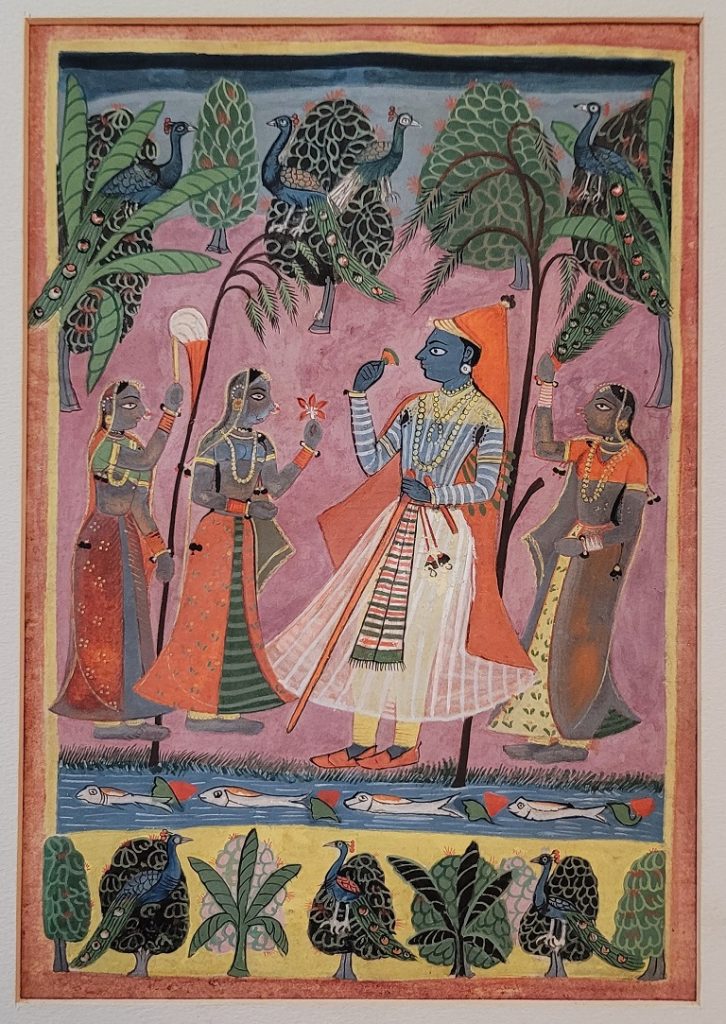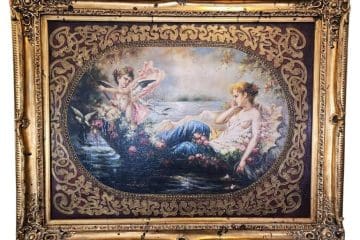19C Indian Miniature Painting of Krishna and Female Gopis by a River
PRESENTING a VERY RARE 19C Indian Miniature Painting of Krishna and Female Gopis by a River.
Hand-painted on paper, with authentic age.
Indian circa 1860-80 and most likely from Uttar Pradesh.
It features a beautifully detailed set of scenes!
In the top scene there are 4 Peacocks intermixed with trees and foliage.
Below this you have 3 maidens (Gopi’s) and Vishnu (easily identifiable due to his blue skin) in ceremonial dress. The Gopi on the right is fanning Vishnu from behind and the 2 to the left are offering gifts of flowers.
They are all standing on a riverbank with 4 fish swimming bye.
On the other side of the riverbank (the bottom scene) has 3 peacocks nestling amongst trees and foliage.
It is framed and under glass in a vintage antique gold and silver frame and has an ivory board matting. It was re-framed in Dallas in the Mid 20C by ‘Downtown Galleries’ who operated in the 1960’s at 1919 Pacific Ave.
Gopi (Sanskrit: गोपी, IAST: Gopi) or Gopika in Hinduism are worshipped as the consorts and devotees of Krishna within the Vaishnavism and Krishnaism traditions for their unconditional love and devotion (Bhakti) to god Krishna as described in the Sanskrit scriptures like Bhagavata Purana and other Puranic literature. Gopis are often considered as the expansion of goddess Radha, the chief consort of Krishna. The Raslila of gopis with Krishna has inspired various traditional performance art forms and literatures.
According to Indian philosopher, Jiva Goswami, gopis are considered as the eternal beloved and manifestation of the internal spiritual potency of Krishna. Among the gopis, Radha is the chief gopi and is the personification of bliss potency (hladini shakti) of Krishna.[5] She alone manifest the stage of “Mahabhav” or supreme love for Krishna and holds a place of particularly high reverence and importance in a number of religious traditions.
Link: https://en.wikipedia.org/wiki/Gopi
Krishna (/ˈkrɪʃnə/; Sanskrit: कृष्ण IAST: Kṛṣṇa [ˈkr̩ʂɳɐ]) is a major deity in Hinduism. The name comes from a Sanskrit word (कृष्ण, kṛṣṇa) that means “black”, “dark”, “dark blue” or “the all attractive”. He is worshipped as the eighth avatar of Vishnu and also as the Supreme god in his own right. He is the god of protection, compassion, tenderness, and love; and is one of the most popular and widely revered among Indian divinities. Krishna’s birthday is celebrated every year by Hindus on Krishna Janmashtami according to the lunisolar Hindu calendar, which falls in late August or early September of the Gregorian calendar.
The anecdotes and narratives of Krishna’s life are generally titled as Krishna Leela. He is a central character in the Mahabharata, the Bhagavata Purana, the Brahma Vaivarta Purana, and the Bhagavad Gita, and is mentioned in many Hindu philosophical, theological, and mythological texts. They portray him in various perspectives: as a god-child, a prankster, a model lover, a divine hero, and the universal supreme being. His iconography reflects these legends, and shows him in different stages of his life, such as an infant eating butter, a young boy playing a flute, a young boy with Radha or surrounded by female devotees; or a friendly charioteer giving counsel to Arjuna.
The name and synonyms of Krishna have been traced to 1st millennium BCE literature and cults. In some sub-traditions, Krishna is worshipped as Svayam Bhagavan (the Supreme God), and it is sometimes known as Krishnaism. These sub-traditions arose in the context of the medieval era Bhakti movement. Krishna-related literature has inspired numerous performance arts such as Bharatanatyam, Kathakali, Kuchipudi, Odissi, and Manipuri dance. He is a pan-Hindu god, but is particularly revered in some locations, such as Vrindavan in Uttar Pradesh, Dwarka and Junagadh in Gujarat; the Jagannatha aspect in Odisha, Mayapur in West Bengal; in the form of Vithoba in Pandharpur, Maharashtra, Shrinathji at Nathdwara in Rajasthan, Udupi Krishna in Karnataka, Parthasarathy in Tamil Nadu and in Aranmula, Kerala, and Guruvayoorappan in Guruvayoor in Kerala. Since the 1960s, the worship of Krishna has also spread to the Western world and to Africa, largely due to the work of the International Society for Krishna Consciousness (ISKCON)
Link: https://en.wikipedia.org/wiki/Krishna
19C Indian Miniature Painting of Krishna and Female Gopis by a River.
Provenance: From a Quality Dallas Estate.
Dimensions: In Frame: 13.25 x 16.8 in
Visual image is 8 x 5.5 in
Condition: Very Good original condition.
SALE PRICE NOW: $2,600
















